Electrically Induced Liquid–Liquid Phase Transition in a Floating Water Bridge Identified by Refractive Index Variations
Abstract
1. Introduction
2. Materials and Methods
2.1. Experimental
2.2. Electrohydrodynamic Simulation of the Bridge
2.3. Topological Changes in Electrically Stressed Water
3. Results and Discussion
- (1)
- In the needle-plate set-up the water stands still, whereas in the water-bridge set-up there is a continuous electrohydrodynamic flow. Since the hydrodynamic flow and the electric field are intrinsically coupled, small variations in the flow create variations in the field and vice versa. As can be seen from Figure 3, the electric field density is highest in the bridge. Whereas the potential barely changes within the beakers, it drops drastically across the bridge where the dielectric displacement is maximized. The phase transition thus occurs when water enters or leaves the bridge, since at these points the gradients are highest.
- (2)
- In the water-bridge setup the EHD flow also carries charge whereas in the needle-plate set-up the external field induces a phase transition without internal disturbances. In the water bridge, the boson condensate is locally distorted by hydrated, electrolytic protons flowing through the bridge from anode to cathode. Such distortions can, in principle, be separated into three distinct situations:
- (a).
- Suppose the influence of the disturbing charges is weaker than the Goldstone correlation strength among dipoles in the ground state. In this case, according to the low energy theorem [48], the correlation cannot be disturbed.
- (b).
- Suppose the disturbing field from local charges to be much stronger than the dipole correlation field. In that case any correlation is immediately destroyed, and a phase transition cannot be induced. This situation has been observed experimentally as EHD instabilities in the water bridge due to the addition of ions, which result in the destruction of the liquid bridge [49].
- (c).
- The disturbing charge field is locally restricted and dampens the SBS locally. This is most likely the case in the water-bridge set-up. Here, the electrically induced phase correlation between the molecular vibrations forms periodically, or stochastically, due to variations in the charge density caused by the changes in vorticity shown in Figure 3c. As a result a flow of phase transitions according to the nonlinear time-dependent Ginzburg–Landau Equation (13) is observed.
4. Conclusions and Outlook
Author Contributions
Funding
Institutional Review Board Statement
Informed Consent Statement
Data Availability Statement
Acknowledgments
Conflicts of Interest
References
- Armstrong, W.G. The Newcastle Literary and Philosophical Society. Electr. Eng. 1893, 154–155. [Google Scholar]
- Mugele, F.; Baret, J.C. Electrowetting: From basics to applications. J. Phys. Condens. Matter 2005, 17, R705. [Google Scholar] [CrossRef]
- Sumoto, I. Climbing of liquid dielectrics up along electrode. Oyo Butsuri 1956, 25, 264. [Google Scholar]
- Uhlig, W. Personal Communication; Laboratory of Inorganic Chemistry, ETH Hönggerberg–HCI: Zürich, Switzerland, 2005. [Google Scholar]
- Fuchs, E.C.; Woisetschläger, J.; Gatterer, K.; Maier, E.; Pecnik, R.; Holler, G.; Eisenkölbl, H. The floating water bridge. J. Phys. D Appl. Phys. 2007, 40, 6112–6114. [Google Scholar] [CrossRef]
- Widom, A.; Swain, J.; Silverberg, J.; Sivasubramanian, S.; Srivastava, Y.N. Theory of the Maxwell pressure tensor and the tension in a water bridge. Phys. Rev. E 2009, 80, 016301. [Google Scholar] [CrossRef]
- Marin, A.G.; Lohse, D. Building water bridges in air: Electrohydrodynamics of the floating water bridge. Phys. Fluids 2010, 22, 122104. [Google Scholar] [CrossRef]
- Morawetz, K. The effect of electromagnetic fields on a charged catenary. AIP Adv. 2012, 2, 022146. [Google Scholar] [CrossRef]
- Morawetz, K. Theory of water and charged liquid bridges. Phys. Rev. E 2012, 86, 026302. [Google Scholar] [CrossRef] [PubMed]
- Morawetz, K. Reversed Currents in Charged Liquid Bridges. Water 2017, 9, 353. [Google Scholar] [CrossRef]
- Wexler, A.D.; Drusová, S.; Fuchs, E.C.; Woisetschläger, J.; Reiter, G.; Fuchsjäger, M.; Reiter, U. Magnetic resonance imaging of flow and mass transfer in electrohydrodynamic liquid bridges. J. Vis. 2017, 20, 97. [Google Scholar] [CrossRef]
- Aerov, A.A. Why the water bridge does not collapse. Phys. Rev. E 2011, 84, 036314. [Google Scholar] [CrossRef]
- Teschke, O.; Soares, D.M.; Gomes, W.E.; Filho, J.F.V. Floating liquid bridge charge dynamics. Phys. Fluids 2016, 28, 012105. [Google Scholar] [CrossRef]
- Teschke, O.; Soares, D.M.; Filho, J.F.V. Floating liquid bridge tensile behavior: Electric-field-induced Young’s modulus measurements. Appl. Phys. Lett. 2013, 103, 251608. [Google Scholar] [CrossRef]
- Woisetschläger, J.; Wexler, A.D.; Holler, G.; Eisenhut, M.; Gatterer, K.; Fuchs, E.C. Horizontal bridges in polar dielectric liquids. Exp. Fluids 2012, 52, 193–205. [Google Scholar] [CrossRef]
- Ponterio, R.C.; Pochylski, M.; Aliotta, F.; Vasi, C.; Fontanella, M.E.; Saija, F. Raman scattering measurements on a floating water bridge. J. Phys. D Appl. Phys. 2010, 43, 175405. [Google Scholar] [CrossRef]
- Fuchs, E.C.; Bitschnau, B.; Woisetschläger, J.; Maier, E.; Beuneu, B.; Teixeira, J. Neutron scattering of a floating heavy water bridge. J. Phys. D Appl. Phys. 2009, 42, 065502. [Google Scholar] [CrossRef]
- Fuchs, E.C.; Bitschnau, B.; di Fonzo, S.; Gessini, A.; Woisetschläger, J.; Bencivenga, F. Inelastic UV Scattering in a Floating Water Bridge. J. Phys. Sci. Appl. 2011, 1, 135–147. [Google Scholar]
- Woisetschläger, J.; Gatterer, K.; Fuchs, E.C. Experiments in a Floating Water Bridge. Exp. Fluids 2010, 48, 121–131. [Google Scholar] [CrossRef]
- Rai, D.; Kulkani, A.D.; Gejiji, S.P.; Pathak, R.K.J. Exploring electric field induced structural evolution of water clusters, (H2O)n [n = 9–20]: Density functional approach. J. Chem. Phys. 2008, 128, 034310. [Google Scholar] [CrossRef] [PubMed]
- Choi, Y.C.; Pak, C.; Kim, K.S. Electric field effects on water clusters (n = 3–5): Systematic ab initio study of structures, energetics, and transition states. J. Chem. Phys. 2006, 124, 094308. [Google Scholar] [CrossRef] [PubMed]
- Saitta, A.M.; Saija, F.; Giaquinta, P.V. Ab Initio Molecular Dynamics Study of Dissociation of Water under an Electric Field. Phys. Rev. Lett. 2012, 108, 207801. [Google Scholar] [CrossRef]
- Stuve, E.M. Ionization of water in interfacial electric fields: An electrochemical view. Chem. Phys. Lett. 2012, 519–520, 1–18. [Google Scholar] [CrossRef]
- Piatkowski, L.; Wexler, A.D.; Fuchs, E.C.; Schoenmaker, H.; Bakker, H.J. Ultrafast vibrational energy relaxation of the water bridge. PCCP 2012, 14, 6160–6164. [Google Scholar] [CrossRef] [PubMed]
- Oshurko, V.B.; Ropyanoi, A.A.; Fedorov, A.N.; Fedosov, M.V.; Shelaeva, N.A. Spectrum of OH-Stretching Vibrations of Water in a “Floating” Water Bridge. Technol. Phys. 2012, 57, 1589–1592. [Google Scholar] [CrossRef]
- Teschke, O.; de Castro, J.R.; Filho, J.F.V.; Soares, D.M. Protonic charge defect structures in floating water bridges observed as Zundel and Eigen solvation arrangements. Chem. Phys. Lett. 2017, 685, 239–243. [Google Scholar] [CrossRef]
- Teschke, O.; de Castro, J.R.; Filho, J.F.V.; Soares, D.M. Hydrated Excess Proton Raman Spectral Densities Probed in Floating Water Bridges. ACS Omega 2018, 3, 13977–13983. [Google Scholar] [CrossRef]
- Teschke, O.; de Castro, J.R.; Gomes, W.E.; Soares, D.M. Hydrated excess protons and their local hydrogen bond transport network as measured by translational, librational, and vibrational frequencies. J. Chem. Phys. 2019, 150, 234501. [Google Scholar] [CrossRef] [PubMed]
- Sammer, M.; Wexler, A.D.; Kuntke, P.; Wiltsche, H.; Stanulewicz, N.; Lankmayr, E.; Woisetschläger, J.; Fuchs, E.C. Proton production, neutralisation and reduction in a floating water bridge. J. Phys. D Appl. Phys. 2015, 48, 415501. [Google Scholar] [CrossRef]
- Fuchs, E.C.; Bitschnau, B.; Wexler, A.D.; Woisetschläger, J.; Freund, F.T. A Quasi-Elastic Neutron Scattering Study of the Dynamics of Electrically Constrained Water. J. Phys. Chem. B 2015, 119, 15892–15900. [Google Scholar] [CrossRef]
- Fuchs, E.C.; Cherukupally, A.; Paulitsch-Fuchs, A.H.; Agostinho, L.L.F.; Wexler, A.D.; Woisetschläger, J.; Freund, F.T. Investigation of the Mid-Infrared Emission of a Floating Water Bridge. J. Phys. D Appl. Phys. 2012, 45, 475401. [Google Scholar] [CrossRef]
- Wexler, A.D.; Sáenz, M.L.; Schreer, O.; Woisetschläger, J.; Fuchs, E.C. The Preparation of Electrohydrodynamic Bridges from Polar Dielectric Liquids. J. Vis. Exp. 2014, 91, e51819. [Google Scholar] [CrossRef] [PubMed]
- Wexler, A.D.; Drusová, S.; Woisetschläger, J.; Fuchs, E.C. Non-equilibrium thermodynamics and collective vibrational modes of liquid water in an inhomogeneous electric field. PCCP 2016, 18, 1628–1629. [Google Scholar] [CrossRef]
- Wexler, A.D.; Fuchs, E.C.; Woisetschläger, J.; Vitiello, G. Electrically induced liquid-liquid phase transition in water at room temperature. PCCP 2019, 21, 18541–18550. [Google Scholar] [CrossRef]
- Lancaster, T.; Blundell, S.J. Quantum Field Theory for the Gifted Amateur; Oxford University Press: Oxford, UK, 2014. [Google Scholar]
- Fuchs, E.C.; Gatterer, K.; Holler, G.; Woisetschläger, J. Dynamics of the Floating Water Bridge. J. Phys. D Appl. Phys. 2008, 41, 185502–185507. [Google Scholar] [CrossRef]
- Higgs, P.W. Spontaneous Symmetry Breakdown without Massless Bosons. Phys. Rev. 1966, 145, 1156–1163. [Google Scholar] [CrossRef]
- del Giudice, E.; Vitiello, G. Role of the magnetic field in the formation of domains in the process of symmetry breaking phase transitions. Phys. Rev. A 2006, 74, 022105. [Google Scholar] [CrossRef]
- Glauber, R.J. Coherent and Incoherent States of the Radiation Field. Phys. Rev. 1963, 131, 2766–2788. [Google Scholar] [CrossRef]
- Blasone, M.; Jizba, P.; Vitiello, G. Quantum Field Theory and Its Macroscopic Manifestations, 1st ed.; Imperial College Press: London, UK, 2011. [Google Scholar]
- Haken, H. Generalized Ginzburg-Landau Equation for Phase Transitions-like phenomenon in Lasers, Nonlinear Optics, Hydrodynamics and Chemical Reactions. Z. für Phys. B Condens. Matter 1975, 21, 105–114. [Google Scholar]
- Barybin, A.A. Nonstationary Superconductivity: Quantum Dissipation and Time-Dependent Ginzbburg-Landau Equation. Adv. Cond. Matter Phys. 2011, 1, 1–10. [Google Scholar] [CrossRef]
- Freeman, W.J.; Livi, R.; Obinata, M.; Vitiello, G. Cortical pahse transitions, nonequilibrium thermodynamics and the time-dependent Ginzburg-Landau equation. Int. J. Mod. Phys. B 2012, 26, 1250035. [Google Scholar] [CrossRef]
- Meyer, G.; Vitiello, G. On the molecular dynamics in the hurricane interactions with its environment. Phys. Lett. A 2018, 382, 1441–1448. [Google Scholar] [CrossRef]
- Fuchs, E.C.; Yntema, D.; Woisetschläger, J. Raman spectroscopy and shadowgraph visualization of excess protons in high-voltage electrolysis of pure water. J. Phys. D Appl. Phys. 2019, 52, 365302. [Google Scholar] [CrossRef]
- Skinner, L.B.; Benmore, C.J.; Shyam, B.; Weber, J.K.R.; Parise, J.B. Structure of the floating water bridge and water in an electric field. PNAS 2012, 109, 16463–16468. [Google Scholar] [CrossRef] [PubMed]
- Kittel, C. Introduction to Solid State Physics, Chapter 16, 8th ed.; John Wiley & Sons: Hoboken, NJ, USA, 2005; ISBN 0-411-41526-X; ISBN 0-471-68057-5. [Google Scholar]
- del Giudice, E.; Doglia, S.; Milani, M.; Vitiello, G. Electromagnetic field and spontaneous symmetry breaking in biological matter. Nucl. Phys. B 1986, 275, 185–199. [Google Scholar] [CrossRef]
- Nishiumi, H.; Honda, F. Effects of Electrolyte on Floating Water Bridge. Res. Lett. Phys. Chem. 2009, 2009, 371650. [Google Scholar] [CrossRef]
- Paulitsch-Fuchs, A.H.; Fuchs, E.C.; Wexler, A.D.; Freund, F.T.; Rothschild, L.J.; Cherukupally, A.; Euverink, G.-J.W. Prokaryotic transport in electrohydrodynamic structures. Phys. Biol. 2012, 9, 026006. [Google Scholar] [CrossRef]
- Paulitsch-Fuchs, A.H.; Zsohár, A.; Wexler, A.D.; Zauner, A.; Kittinger, C.; de Valença, J.; Fuchs, E.C. Behavioral study of selected microorganisms in an aqueous electrohydrodynamic liquid bridge. Biochem. Biophys. Rep. 2017, 10, 287–296. [Google Scholar] [CrossRef]
- Feynman, R.; Leighton, M.; Sands, M. The Feynman Lectures on Physics, New Millennium ed.; Basic Books: New York, NY, USA, 2010; Volume II, ISBN 978-0-465-02416-2. [Google Scholar]
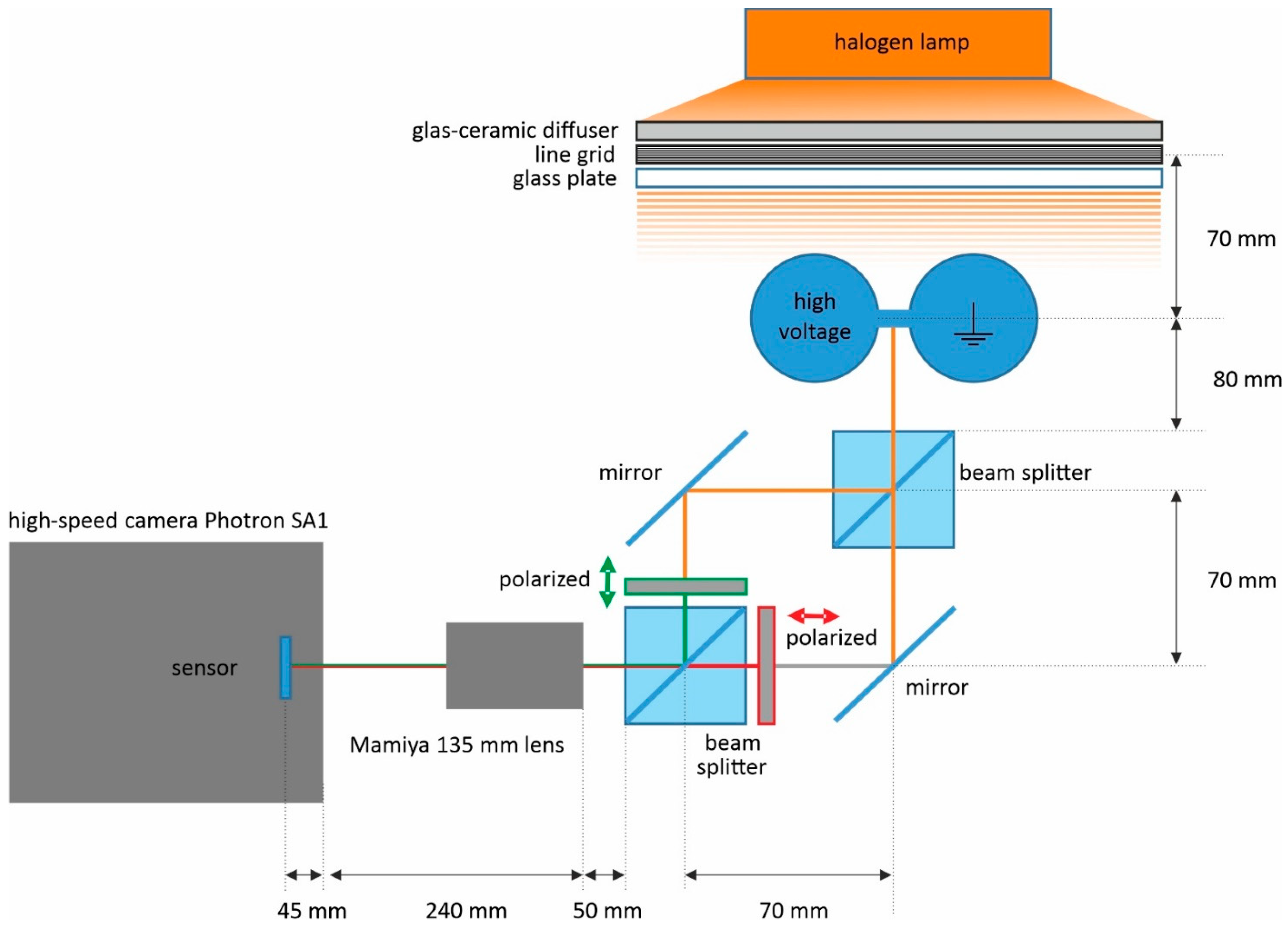
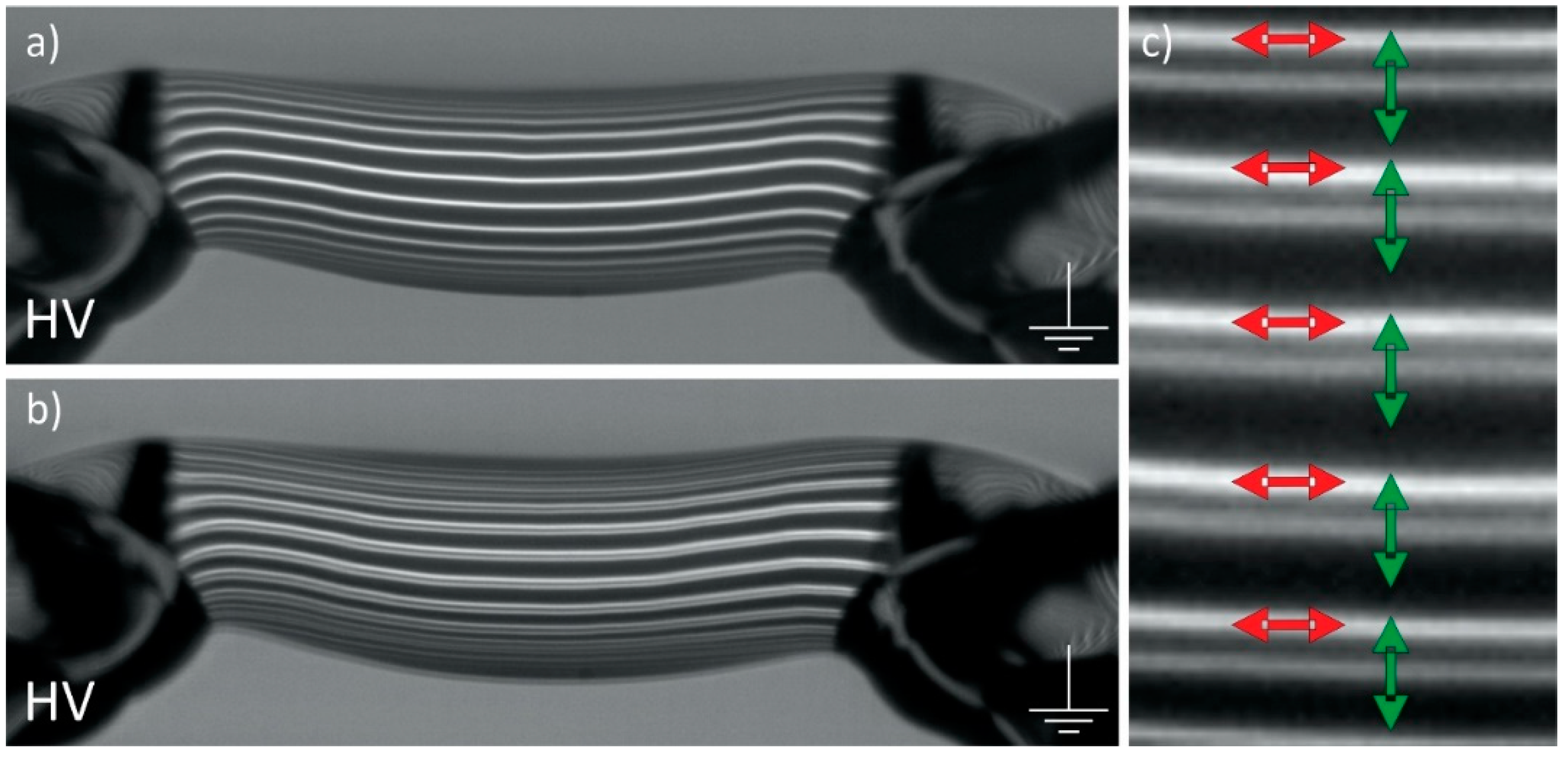
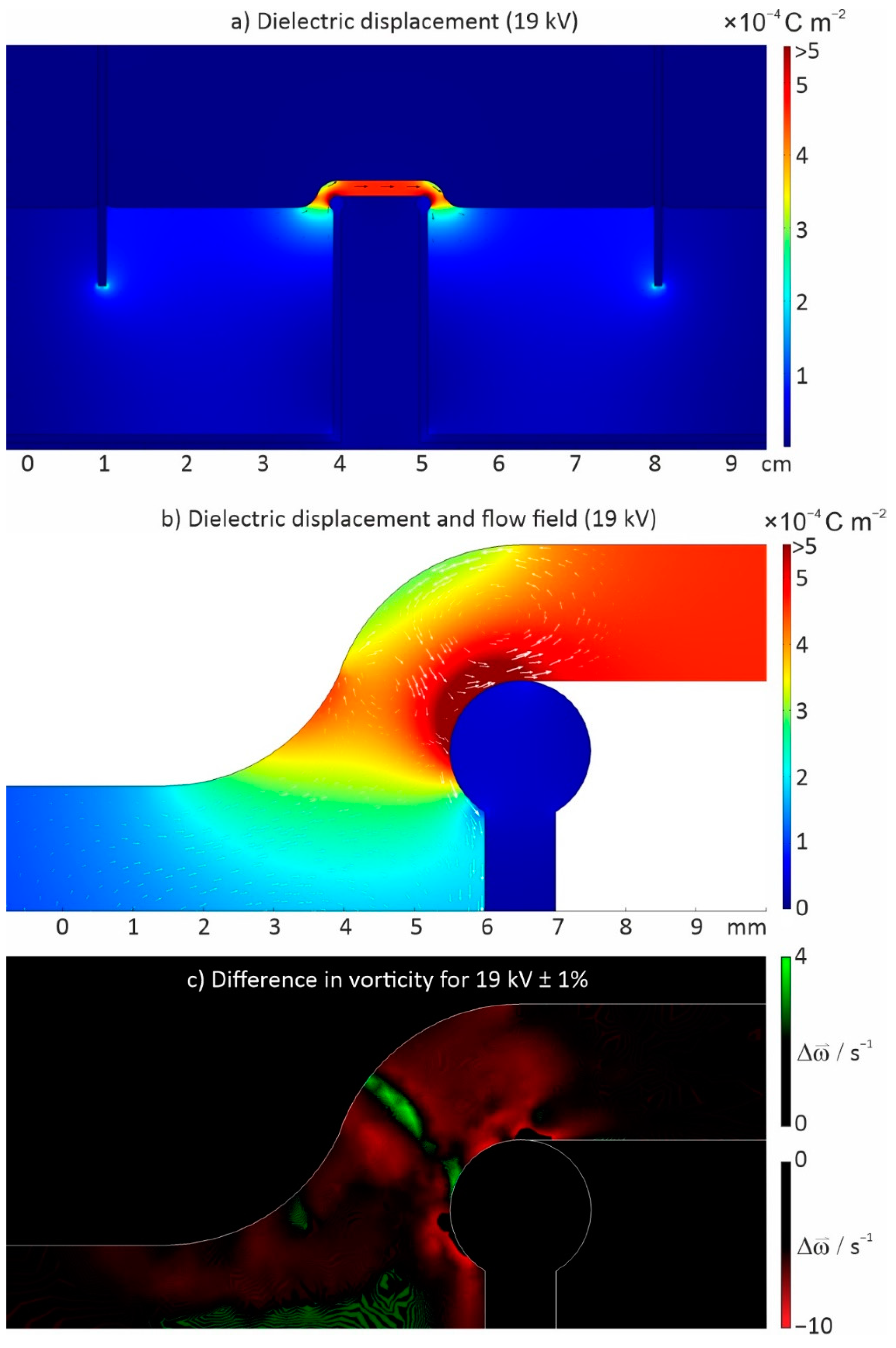

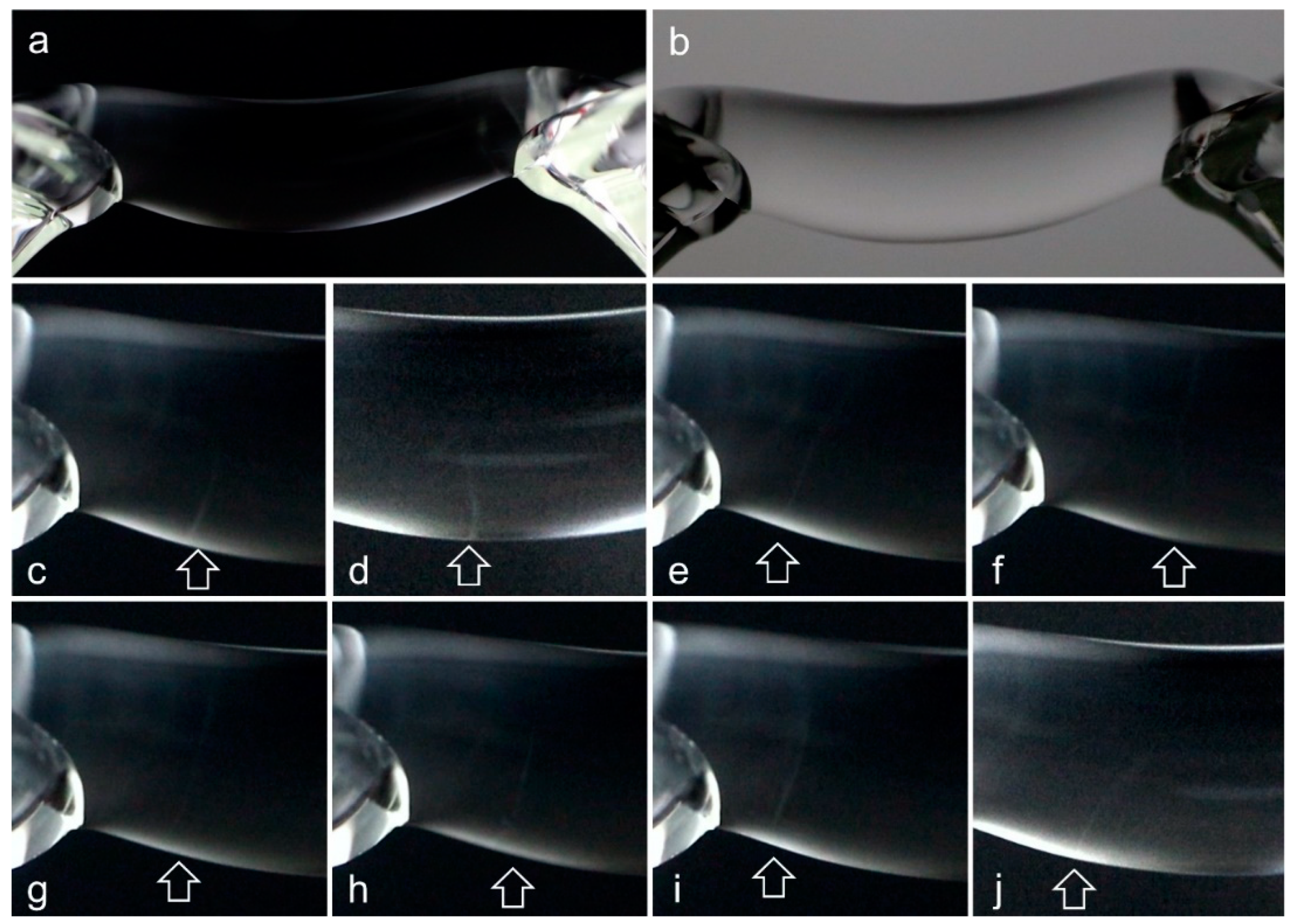


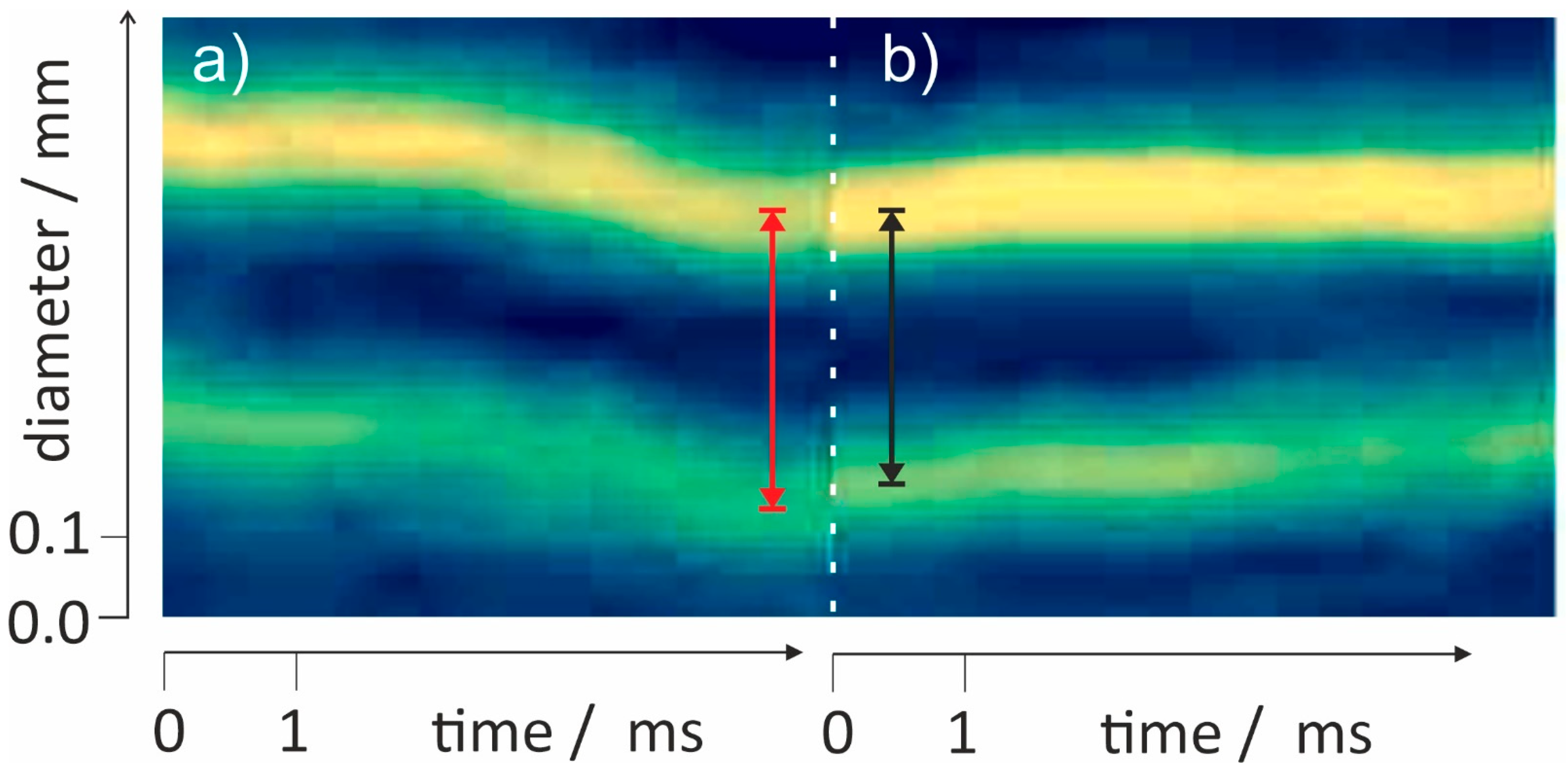
Publisher’s Note: MDPI stays neutral with regard to jurisdictional claims in published maps and institutional affiliations. |
© 2021 by the authors. Licensee MDPI, Basel, Switzerland. This article is an open access article distributed under the terms and conditions of the Creative Commons Attribution (CC BY) license (http://creativecommons.org/licenses/by/4.0/).
Share and Cite
Fuchs, E.C.; Woisetschläger, J.; Wexler, A.D.; Pecnik, R.; Vitiello, G. Electrically Induced Liquid–Liquid Phase Transition in a Floating Water Bridge Identified by Refractive Index Variations. Water 2021, 13, 602. https://doi.org/10.3390/w13050602
Fuchs EC, Woisetschläger J, Wexler AD, Pecnik R, Vitiello G. Electrically Induced Liquid–Liquid Phase Transition in a Floating Water Bridge Identified by Refractive Index Variations. Water. 2021; 13(5):602. https://doi.org/10.3390/w13050602
Chicago/Turabian StyleFuchs, Elmar C., Jakob Woisetschläger, Adam D. Wexler, Rene Pecnik, and Giuseppe Vitiello. 2021. "Electrically Induced Liquid–Liquid Phase Transition in a Floating Water Bridge Identified by Refractive Index Variations" Water 13, no. 5: 602. https://doi.org/10.3390/w13050602
APA StyleFuchs, E. C., Woisetschläger, J., Wexler, A. D., Pecnik, R., & Vitiello, G. (2021). Electrically Induced Liquid–Liquid Phase Transition in a Floating Water Bridge Identified by Refractive Index Variations. Water, 13(5), 602. https://doi.org/10.3390/w13050602








